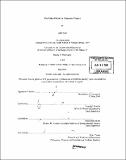| dc.contributor.advisor | James M. Poterba and Antoinette Schoar. | en_US |
| dc.contributor.author | Sufi, Amir | en_US |
| dc.contributor.other | Massachusetts Institute of Technology. Dept. of Economics. | en_US |
| dc.date.accessioned | 2006-03-29T18:40:57Z | |
| dc.date.available | 2006-03-29T18:40:57Z | |
| dc.date.copyright | 2005 | en_US |
| dc.date.issued | 2005 | en_US |
| dc.identifier.uri | http://hdl.handle.net/1721.1/32397 | |
| dc.description | Thesis (Ph. D.)--Massachusetts Institute of Technology, Dept. of Economics, 2005. | en_US |
| dc.description | Includes bibliographical references. | en_US |
| dc.description.abstract | This dissertation consists of three chapters that examine the importance of commercial banks in the financing decisions of corporations. The first chapter focuses on syndicated loans. The syndicated loan market is an increasingly important source of corporate finance, with over $1 trillion in new syndicated loans signed annually. The first chapter empirically explores the syndicated loan market with an emphasis on how information asymmetry and renegotiation considerations influence syndicate structure and the choice of participant lenders. There are two principal findings. First, when the borrower requires more intense investigation and monitoring effort by a financial institution, the lead arranger retains a larger portion of the loan, forms a more concentrated syndicate, and chooses participants that are closer to the borrower (both geographically and in terms of previous relationships). The evidence is consistent with moral hazard in a setting of information asymmetry. The lead arranger attempts to guarantee due diligence effort by increasing its risk exposure, and the lead arranger chooses lenders that minimize information asymmetry. Second, when the borrower is more likely to need to renegotiate the loan agreement, lead arrangers add participants with very small portions of the loan to the syndicate. Given that unanimity of lenders is needed to renegotiate major terms of the loan, adding participants with small portions of the loan reduces the renegotiation surplus expected by the borrower. The evidence suggests that lenders form syndicates to reduce inefficient behavior and strategic default by borrowers. The second chapter focuses on the use of bank lines of credit by corporations. Commercial bank lines of credit are used by more U.S. corporations than any other type of debt financing. Using novel data from annual 10-K SEC filings for a random sample of public firms, I analyze how corporate lines of credits are used by firms, how they are managed by banks, and which types of firms obtain lines of credit. The evidence suggests that lines of credit are the incremental source of debt financing for firms, and that banks carefully manage their use through covenants on profitability. Among firms that have lines of credit, a negative earnings shock leads to a restriction of the unused portion of the lines. Among all firms, only firms with high profitability are able to obtain lines of credit. The results suggest that lines of credit provide bank-managed flexibility for the firms that are able to obtain them, but only profitable firms are awarded this flexibility. In the third chapter, I examine the increasing prevalence of commercial banks in the corporate debt underwriting market. The relaxation of restrictions on commercial bank underwriting, culminated in the passage of the Financial Services Modernization Act of 1999, has initiated a major change in debt underwriting markets facing borrowing firms. For the first time since the 1920s, financial institutions are able to jointly produce private lending and underwriting services. Using fixed effects regressions on a panel of 4,553 debt issues by 509 firms from 1990 to 2003, I find that issuing firms receive a 10 to 15 percent reduction in underwriting fees, which is driven by commercial banks jointly offering lending and underwriting services. I show firms are no more locked in to financial relationships after deregulation than before, and that issuing firms add multiple lead managers to prevent a lending commercial bank underwriter from gaining too much power over the firm. While a number of papers analyze commercial bank entry, this work in this chapter is the first to use the effect of exogenous deregulation on within-firm variation over time to estimate key parameters. This methodological contribution is important; I show that cross section (or pooled) regressions produce biased and inconsistent estimates of the effect of commercial banks on yield spreads. The fixed effects strategy employed here calls into question the result in previous research that commercial banks obtain lower yield spreads for borrowing firms. | en_US |
| dc.description.statementofresponsibility | by Amir Sufi. | en_US |
| dc.format.extent | 149 p. | en_US |
| dc.format.extent | 8531550 bytes | |
| dc.format.extent | 8539785 bytes | |
| dc.format.mimetype | application/pdf | |
| dc.format.mimetype | application/pdf | |
| dc.language.iso | eng | en_US |
| dc.publisher | Massachusetts Institute of Technology | en_US |
| dc.rights | M.I.T. theses are protected by copyright. They may be viewed from this source for any purpose, but reproduction or distribution in any format is prohibited without written permission. See provided URL for inquiries about permission. | en_US |
| dc.rights.uri | http://dspace.mit.edu/handle/1721.1/7582 | |
| dc.subject | Economics. | en_US |
| dc.title | The role of banks in corporate finance | en_US |
| dc.type | Thesis | en_US |
| dc.description.degree | Ph.D. | en_US |
| dc.contributor.department | Massachusetts Institute of Technology. Department of Economics | |
| dc.identifier.oclc | 61690740 | en_US |
